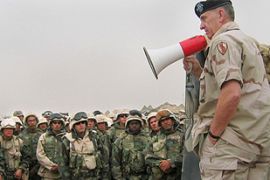US redeploys troops to Afghanistan
US to remove 8,000 troops from Iraq and send 4,500 to Afghanistan, Bush announces.

Nick Spicer, Al Jazeera’s correspondent in Washington, said: “The withdrawal amounts to 5.5% of the troops in Iraq … it’s really not that significant.
“This isn’t the big pull-out some people in the establishment were calling for.”
Decision ‘too late’
Al Jazeera’s Jasim Azawi, the presenter of Inside Iraq, said the decision to “make amends” by removing troops from Iraq was “too late”.
He said: “The legacy, the name, the connection between Iraq and president Bush, is going to be a negative one.
| IN VIDEO |
|
|
“This is the biggest disaster the United States has committed in the 21st century and it will be a long time before the credibility of the United States and the name of president Bush is mentioned in a good sentence.
“The negative effect of the legacy of George Bush is not limited to Iraq, it has spread all over the Arab world as well as the Muslim world.
“The next [US] president is going to [have to] work very hard in order to ameliorate the image of the United States.”
Any large-scale change in US forces in Iraq and Afghanistan will be left to Bush’s successor – either John McCain, the Republican nominee or Barack Obama, the Democratic candidate – after Bush leaves office in January 2009 following the November 4 presidential elections.
Zeina Khodr, Al Jazeera’s correspondent in Kabul, said: “US military commanders have been calling for up to 10,000 troops to be sent … they are facing a resurgent Taliban carrying out bolder attacks.
“The Taliban have not been defeated.”
Voters’ anger
A reduction of 8,000 soldiers would leave 138,000 US government troops in Iraq and there are currently 33,000 in Afghanistan.
That will still be more than before Bush ordered a “surge” of extra forces in 2007 and also more than in November 2006, when his Republicans lost mid-term congressional elections largely due to voter anger over the war.
Bush’s plan follows recommendations from senior US defence officials, including Robert Gates, the defence secretary, Mike Mullen, chairman of the joint chiefs of staff and David Petraeus, the top commander in Iraq.
Obama has promised to withdraw US troops from Iraq within 16 months and said he would put more resources into Afghanistan and “anti-terrorism efforts” along the Pakistan border, where US officials say they believe Osama bin Laden, the al-Qaeda leader, is hiding.
McCain has refused any set any timeline for withdrawing troops from Iraq.
He has said he prefers Bush’s policy of removing them based on commanders’ recommendations and security conditions in the war zone.
‘Fragile and irreversible’
Bush’s “surge” strategy, which sent an additional 30,000 troops to Iraq, has helped stem violence and pulled Iraq back from the brink of civil war, according to White House officials.
The so-called “surge,” which was announced in 2007, was criticised by many Democrats who said the US should be pulling out of the country.
While violence has fallen in Iraq, attacks against US, Nato and Afghan troops in Afghanistan have soared.
Nato commanders there have asked for additional forces for years and say they still need about 12,000 troops.
The US has 33,000 troops in Afghanistan, split between a Nato-led mission and a separate “counter-terrorism” mission run by the Pentagon.
